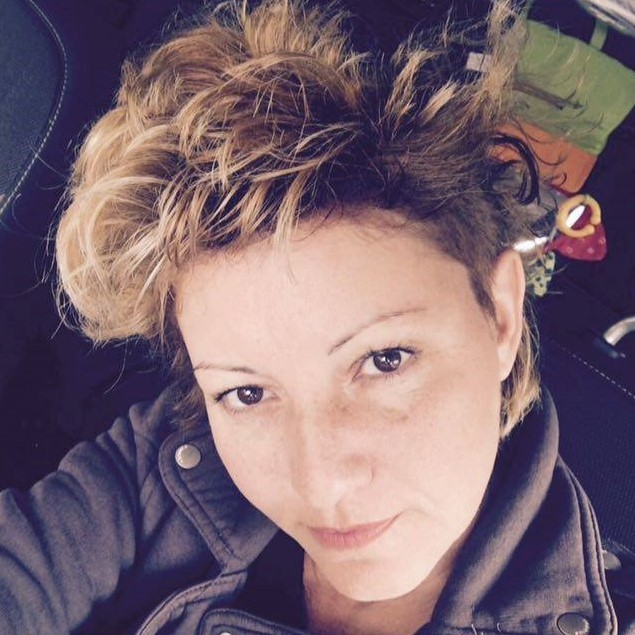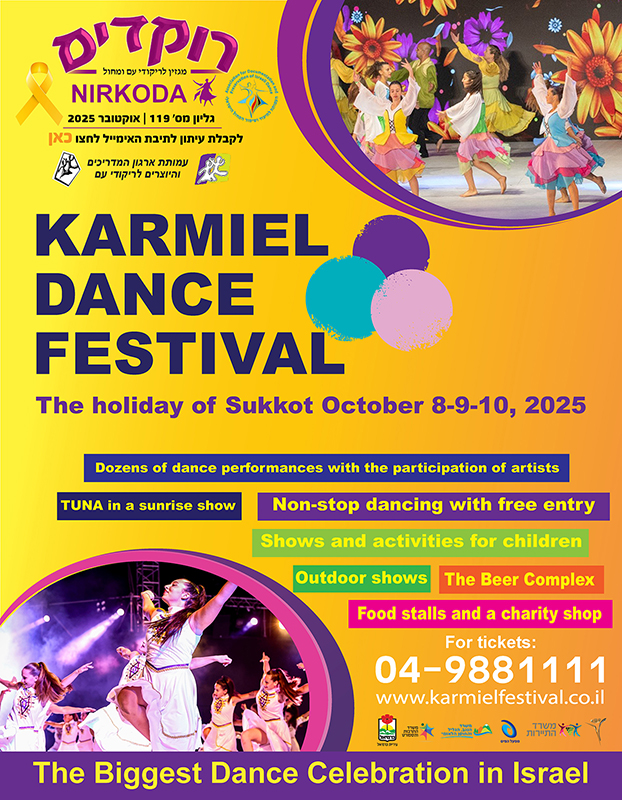- Home
- Rokdim Nirkoda 119
- Complete
Everyone was already dancing when I entered the hall. Couples were spread out from one end to the other. I stood still and watched the couples dancing. In my eyes, each couple looked like one complete unit, as if born dancing together. In the background, a song was playing: “Ahava Ka’zo – This Kind of Love”, the version sung by the singer Zehava Ben. The hall was large and full of white light and the floor was parquet, comfortable for dancing. “This kind of love can’t be found anymore…” sang Zehava.
A couple dancing near me caught my eye. His right hand was holding her left hand and he swung her around in an inner, dizzying circle that belonged only to them. No one could come between them. He continued and stepped around her very slowly while she sailed around and carefully followed his steps, looking up at him – he much taller than her. He gave her a broad smile until the last steps of the dance, until the singer signed off with the words: “Not a day passes that I don’t think of you…”
No, the iron chair that surrounded her body didn’t bother this lovely dancing couple at all. The metal wheels didn’t present an obstacle for the tall dancer. He already knew everything he had to do. He knew how to hold her, how to circle her, to pull her to him and away from him. He was an expert in her characteristics and she was his anchor.
Carmela Lerner (has danced for many years)
At the age of five months, I contracted polio. My parents took me for many physiotherapy treatments at the Hadassah Hospital in Jerusalem. The hospital succeeded in helping my body to reach a point where my left leg functions. It is my strong leg. As a child, I even managed to run. Unfortunately, with the passing years, everything became more difficult. My healthy left leg became weaker, and it was necessary to replace my pelvis. Finally, I ended up in a wheelchair.
I don’t give up that easily. I have lived my life as a normal and healthy person. In my profession, electrical engineering, I worked at “Elta” in Ashdod, at “El-Op” and other such places. I even received the “Outstanding Employee” award. One day, after I retired, I was watching television and saw a dancer dancing in a wheelchair. I said to myself, “I want to do that, too.” After I heard that it was a group for “sitting” (wheelchair) dancers, I bought a suitable chair and, today, I’m a very good and active dancer. Fifteen years ago, I took an instructors’ course and I’m still working as an instructor with Tzipi Atiram in our groups in Rishon LeZion and in Rehovot.
The dances give me happiness, life and joy. They fill my soul. During the day I do all the errands that I have, and in the evening, I go dancing.
In addition to the groups, I also dance in a troupe of dancers in wheelchairs. We give performances abroad. We have danced in the United States, Brazil and Turkey, and have performed in many festivals. It was wonderful.
Within the framework of our performance, I have a solo on stage, alone, but unfortunately, I fell at home several months ago and broke my shoulder. But I still won’t give up for a moment. I go for a lot of physiotherapy at the hospital and am waiting for the moment when I can return to all my activities in the groups and in the troupe.
It’s true my legs don’t work, but my arms and head do. I have a good memory and I enjoy myself. After each dance session my adrenalin level is very high, and I can’t fall asleep because of the euphoria. It’s fun and I wish I could dance all my life.
Tzipi and Adi Atiram married in 1973, have three children and four grandchildren, and are folk dance instructors for the special needs population. They have been instructing these groups for 20 years and they do this with enormous love and an open, giving heart.
Adi:
I have led folk dancing for many years. One day I was a guest at the Rishon LeZion session of Orly Bauer z”l. She led groups of people with special needs. She was a choreographer and moderated many courses for instructors in this field.
When I arrived at the hall, I saw the couples dancing. One couple in particular caught my eye. The male dancer was standing and the female dancer was seated in a wheelchair. The way their dance was synchronized and how they managed together on the dance floor, amazed me. It flowed and looked so natural…. Their movements were completely in sync, as if they’ve been dancing together all their lives. There was another couple: the one seated in the wheelchair had had both legs amputated. But at that moment, it seemed to me that he was the happiest person in the world. He smiled the entire evening, and his body, which seemed “complete”, was enveloping a soul that was at peace with itself, full of joy. This attracted me. I couldn’t stop watching them the entire evening. I wanted the same thing. I wanted to learn and to be an instructor for this kind of group: a group of people sitting in wheelchairs dancing with people who were standing.
In 2004 I registered for the course being given by Orly Bauer z”l and Galit Chaim Cohen: the “Instructors’ Course for People with Special Needs.” After I completed the course, I went to the same session in Rishon LeZion to do my internship and was the partner of one of the wheelchair dancers. Additionally, I studied choreography with choreographer Shlomo Maman, and I also took a course for instructing toddlers and school age children given by Dr. Levi Bar Gil.
In 2005 I decided to open my own group for dancers in wheelchairs. Together with Shmulik Shubeli (chairperson of ILAN and chair of the Rehovot group for people with special needs) and the instructor Leah Hadari, we opened the first dance group in Ness Ziona. I received a budget from the cities of Rehovot, Ness Ziona and Yavneh. The group was named: R”NY (the first letter of the names of each of the three cities). The ILAN organization also helped fund us. During this period, my wife Tzipi was with me for every dance session. She took care of all the necessary extras: refreshments, and organizing the hall, so that everything was as it needed to be. Over time, Tzipi became totally involved in the dance sessions and she danced with us. Tzipi is a wonderful dancer and a woman with a big heart. These characteristics were very present as she instructed people with special needs. Thus, in 2010 I left the group and Tzipi replaced me. Today Tzipi instructs the group and I’m the DJ…
Today, when I see a person sitting in a wheelchair I do my best to show him that we are all equal and that the wheelchair doesn’t have to be an obstacle. I instruct with great love, enjoy every moment with the dancers as well as the camaraderie they have between each other. There’s a lot of help and support within the group. There are some couples who have danced together and then became couples for life. Strong ties of friendship were woven. There are even dancers who won’t come to a session if their partner can’t come. In this dance group, feelings are clean and beautiful. There’s a pure, genuine love. The standing dancers are here as volunteers, but they get greater enjoyment and satisfaction from this than from anything else they do in life.
The people in the group are growing older and we want to bring in younger dancers. We have turned to several municipal mayors with the intention of broadening our activities. We love this field so much and we’ll continue in it forever.
Tzipi:
When Adi first opened the group, I went with him to watch and to make sure all the surrounding needs were taken care of. One day I went to dance with a girl sitting in a wheelchair and I’ve been addicted ever since to the experience. I couldn’t stop. I took the instructors course in 2006 at Givat Washington with Edna Kaveh and Aviva Uri. Today I instruct courses for wheelchair groups (sitting-standing) in Rehovot. In Rishon LeZion I lead a group from AKIM (the Israeli national organization for people with intellectual disabilities and their families) and in Yavneh and Gedera, I lead groups for female retirees.
For me, to dance with those sitting in wheelchairs is something special in my life. There’s a lot of joy and you always see a smile on peoples’ faces.
Very often, a dance needs to be changed in order to perfectly suit the standing dancer and the one who is sitting. Adi and I have adjusted dozens of dances and made them suitable to our groups according to the needs. Not every step can be adjusted and thus a step may need to be changed in order to fit. We don’t see this as a limitation. It is an adaptation. Most of the dances are couple dances.
Shmuel (Shmulik) Shubeli
When the dancer who stands on his feet comes as a volunteer to my sessions, he derives double enjoyment: once for the dance itself and once from the dancer in the wheelchair who is smiling and listening to him throughout the entire dance. There’s enormous satisfaction in this. Most of the handicapped in the group are victims of polio, which was very prevalent during the fifties and sixties. And then things changed. About 30 years ago groups were opened for us and this gave us so much pleasure. The person in the wheelchair feels the same soul-inspiring feeling as the person standing. There’s no difference. The soul is what dances. When I dance and my partner stands opposite me, it seems to me that her legs actually feel like they are mine. I watch her movements and it’s as if I’m doing them.
In 2004 Adi came to me and said: “Shmulik”, let’s open a group for handicapped dancers together”. There was an existing group in Rishon LeZion and Adi wanted to open a group in Rehovot. We got involved: Adi, me, and Leah Hadari – and together we started a group.
Tzipi, who was always with us, replaced Adi after several years. It was important to me to find a solution for the people of Rehovot and of Ness Ziona, and to our great joy, many handicapped people from the area heard about this brand-new group and joined us. I remember that we distributed fliers advertising the group, and visited regular folk dance groups in order to encourage dancers to volunteer to be the standing dancer. The response was overwhelming.
Today, we have an annual nation-wide Purim carnival. We are hosted each time by a different instructor. We’ve appeared at the sessions of Rafi Ziv, Itzik Ben Dahan, Tamir Shalev and many other good people.
In addition, we dance and instruct every year at Karmiel. Our group dances in the center of the hall, and people who are part of the regular dance groups dance around us, like an envelope. From a bird’s eye view it is beautiful and very emotional, looking like a colorful flower that is opening its leaves.
Carmel Tzedaka (the group’s technical man, responsible for budgets)
In the past I worked as a mechanic with the El-Op Company, which belongs to Elbit. I learned a lot there. My being in a wheelchair didn’t stop me from progressing in life. In 2012 I retired and came to watch the group. Shmulik and I have been good friends since we were together in summer camp as children. When I first came to the group, I fell in love with the people who were there, with the feeling that they gave to me. I saw only light and goodness. I decided that I would stay and work with the group, fixing the wheelchairs of the dancers. We have a large quantity of wheelchairs that are suitable for dancing and I make sure to repair them and make them suitable for each seated dancer. I’m here as a volunteer and I’m happy about it. I dance in the group and enjoy it very much.
Adi: In conclusion, I have a dream. My ambition is that groups particularly suitable to a special needs population will open, expand, and become stronger. There should be a suitable solution all over the country. We in Israel are presently going through a very complicated period. There are many wounded soldiers who have become amputees. I believe their rehabilitation should include a place where the body and the soul are expressed together. Music, suitable dance steps and joining together in a social setting can contribute to the emotional healing and self-esteem of the wounded. There should be more awareness of this field. We really can help.









Comments
התראות